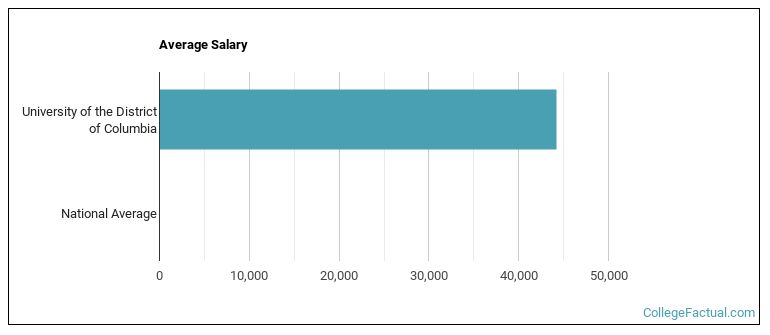 by our College Data Analytics Team
by our College Data Analytics TeamIn its yearly rankings, College Factual analyzes over 2,000 colleges and universities to determine which ones are the best in a variety of categories, such as overall value, quality, diversity, which schools are the best for each major, and much more.
University of the District of Columbia was awarded 30 badges in the 2025 rankings. The highest ranked major at the school is education.
Explore the best ranked schools for the programs you are most interested in.
University of the District of Columbia landed the #1,671 spot in College Factual's 2025 ranking of best overall colleges in the United States. The higher ed experts analyzed 2,152 colleges and universities across the nation to determine this ranking.
Out of the 7 colleges in District of Columbia, University of the District of Columbia is ranked at #7.
See all of the rankings for University of the District of Columbia.
Since University of the District of Columbia has an open admissions policy, being accepted to the school isn't that hard. However, a full basic things - such as a high school diploma or equivalent - may be required. Also, go over your application to make sure it is complete before you submit it.
At University of the District of Columbia, the student to faculty ratio is an excellent 6 to 1. That's much better than the national average of 15 to 1. This indicates that many classes will probably be small, and students will have ample opportunites to work closely with their professors and classmates.
When estimating how much access students will have to their teachers, some people like to look at what percentage of faculty members are full time. This is because part-time teachers may not have as much time to spend on campus as their full-time counterparts.
The full-time faculty percentage at University of the District of Columbia is 33%. This is lower than the national average of 47%.
The freshmen retention rate is a sign of how many full-time students like a college or university well enough to come back for their sophomore year. At University of the District of Columbia this rate is 54%, which is a bit lower than the national average of 68%.
When we say that a student has graduated on time, we mean that they have finished their bachelor's degree within four years. The on-time graduation rate at University of the District of Columbia is 21%. That's lower than the national rate of 33.3%
Find out more about the retention and graduation rates at University of the District of Columbia.
During the 2017-2018 academic year, there were 3,385 undergraduates at University of the District of Columbia with 1,614 being full-time and 1,771 being part-time.
| $0-30 K | $30K-48K | $48-75 | $75-110K | $110K + |
|---|---|---|---|---|
| $13,708 | $13,821 | $13,920 | $18,015 | $16,227 |
The net price is calculated by adding tuition, room, board and other costs and subtracting financial aid.Note that the net price is typically less than the published for a school. For more information on the sticker price of University of the District of Columbia, see our tuition and fees and room and board pages.
While almost two-thirds of students nationwide take out loans to pay for college, the percentage may be quite different for the school you plan on attending. At University of the District of Columbia, approximately 19% of students took out student loans averaging $5,462 a year. That adds up to $21,848 over four years for those students.
Get more details about paying for University of the District of Columbia.

See which majors at University of the District of Columbia make the most money.
Get more details about the location of University of the District of Columbia.

Contact details for University of the District of Columbia are given below.
| Contact Details | |
|---|---|
| Address: | 4200 Connecticut Ave Nw, Washington, DC 20008 |
| Phone: | 202-274-5000 |
| Website: | www.udc.edu/ |
| Most Popular Majors | Bachelor’s Degrees | Average Salary of Graduates |
|---|---|---|
| Business Administration & Management | 88 | $35,894 |
| Law | 63 | NA |
| General Education | 38 | NA |
| Computer Science | 36 | $65,524 |
| Bioethics/Medical Ethics | 36 | NA |
| General Biology | 30 | NA |
| Political Science & Government | 30 | $49,935 |
| Liberal Arts General Studies | 25 | NA |
| Accounting | 21 | $61,610 |
| Design & Applied Arts | 21 | NA |
Online courses area a great option for busy, working students as well as for those who have scheduling conflicts and want to study on their own time. As time goes by, expect to see more and more online learning options become available.
In 2022-2023, 1,016 students took at least one online class at University of the District of Columbia. This is an increase from the 819 students who took online classes the previous year.
| Year | Took at Least One Online Class | Took All Classes Online |
|---|---|---|
| 2022-2023 | 1,016 | 13 |
| 2021-2022 | 819 | 10 |
| 2020-2021 | 811 | 0 |
| 2018-2019 | 426 | 0 |
Learn more about online learning at University of the District of Columbia.
If you’re considering University of the District of Columbia, here are some more schools you may be interested in knowing more about.
Curious on how these schools stack up against University of the District of Columbia? Pit them head to head with College Combat, our free interactive tool that lets you compare college on the features that matter most to you!
Footnotes
*The racial-ethnic minorities count is calculated by taking the total number of students and subtracting white students, international students, and students whose race/ethnicity was unknown. This number is then divided by the total number of students at the school to obtain the racial-ethnic minorities percentage.
References
More about our data sources and methodologies.